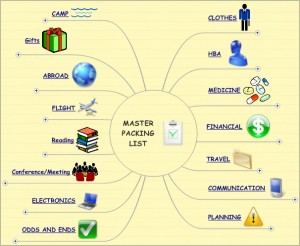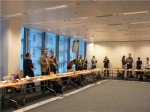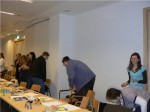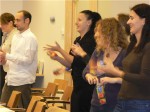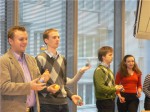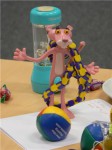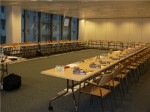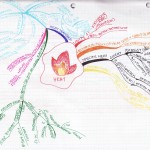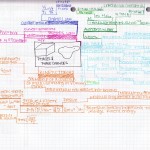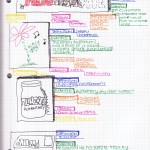An Idea Mapping Success Blogs Weblog
Seeking Contestants for the 12th Annual USA Memory Championship
9 Feb 2009 Author: Jamie Nast In: MemoryThis article ran today regarding the USA Memory Championship. Anyone up for the challenge?
Recorded Version of Jamie’s Recent Mindjet Webinar
4 Feb 2009 Author: Jamie Nast In: Group Idea Maps, Idea Mapping Example, Idea Mapping Software, Idea Maps for Meetings, Interviews, MindManager, Productivity, Real-Time Idea Maps, WebinarsOn January 22, 2009 I did a webinar with Mindjet titled, “Increasing Productivity with Idea Mapping”. Lisa Fait was the MC and Michael Deutch was the interviewer. Learn more about Idea Mapping and see some really cool examples from mappers around the globe! Listen to the recorded version.
Idea Map #141 – Packing and Mindjet Newsletter Feature
26 Jan 2009 Author: Jamie Nast In: Idea Mapping Example, Idea Mapping Workshops, Mind Mapping Examples, MindManager, ProductivityDr. Tim Schweizer is a Professor of Management at Luther College in Decorah, IA. He is also a Certified Trainer: Six Thinking Hats™, Lateral Thinking™ (Edward de Bono tools), and Vice President, Altshuller Institute for TRIZ Studies. He is currently on a year-long sabbatical working as an independent consultant to the Energy and Environmental Security Directorate, a new and entirely unclassified program to the Office of Intelligence and Counterintelligence in the U.S. Department of Energy. Tim and I met in August of 2008 when he attended one of my public Idea Mapping Workshops.
One of Tim’s idea maps (different that today’s posting) is now featured in my January column of the Mindjet Newsletter and it should be there for the next four weeks. Once the February Mindjet Newsletter is up I’ll make sure that this incredible story is posted on this blog. Search for “Tim Schweizer”. In that example he used MindManager to design a GTD (Getting Things Done by David Allen) system that you won’t want to miss. You will see in detail how you can more effectively get things done by following his design and applying it for yourself. If you want a copy of the full blown map in MindManager format, email me at jamie(at)ideamappingsuccess(dot)com. For the pdf version click here.
TODAY’S POSTING
Rather than duplicate what you can see in the Mindjet Newsletter, I thought I would share a different idea map from Tim today. He created a Master Packing Map and used the “Writing Project” template in MindManager 8 to get off to a quick start to give it a different look. Unfortuantely I had to close all of the branches so that it could be readable even at this level. The packing map was very detailed. If you want a copy of the full blown map in MindManager format, email me at jamie(at)ideamappingsuccess(dot)com. For the pdf version click here.
According to Tim, “The advantage of using this map (over a list) is that some parts of the map can be “closed” if that is not relevant. The best example is the Camp section. That stuff is totally irrelevant unless going to summer camp with my family. Another good example is the Abroad section. I don’t need to worry about visas, passports, etc. when traveling domestically. A few things are duplicated on the map, because they are used in different settings. The backpack is out of place – I put a boundary around it. I have it set for airline use, though I would use it for all travel.”
See Tim’s GTD map on today’s new January 2009 Mindjet Newsletter!
As I reflect on 2008 I was blessed with some wonderful experiences and the opportunity to meet many terrific people. But this particular event stands out because it was very unusual for me. I had never been to eastern Europe. I was invited to come to Warsaw, Poland in November of 2008 by Dr. Karol Olejniczak who is a professor at EUROREG – University of Warsaw. He runs a program called Academy of Evaluation which is financed and sponsored by Polish Ministry of Regional Development.
This program runs nine months and this group of 50 of Poland’s most brilliant civil servants meets for two days twice a month. Quite a commitment. As part of this program I taught Idea Mapping and the MindManager software program. These dedicated governmental employees are part of a critical effort to rebuild Poland’s infrastructure and to measure the success of those projects.
The photos you see are mainly from an activity where participants are taught to juggle as an analogy for learning. They are put in a situation where most adults don’t think they can learn something new, come face-to-face with their disbelief, learn how that impacts learning, and taught a learning model. The juggling itself is then broken down into manageable pieces and everyone improves while some actually master the juggling. They were a gracious, warm, open-minded group of professionals that gave me more than I gave them.
Can Scientists Read Your Mind? – CBS 60 Minutes News Segment
20 Jan 2009 Author: Jamie Nast In: Brain ResearchMindjet Webinar January 22, 2009 1PM Pacific Time
18 Jan 2009 Author: Jamie Nast In: MindManager, WebinarsRegister for the upcoming 1-hour event with Mind hosts Lisa Fait and Michael Deutch. NastGroup founder and Idea Mapping author, Jamie Nast, in this webinar as we explore how idea mapping in MindManager can help you and your colleagues increase productivity every day.
Will Mind Mapping Software Go Mainstream in 2009?
17 Jan 2009 Author: Jamie Nast In: Mind Mapping SoftwareJoin the discussion around this topic started by Chuck Frey.
11th Grade Studying – Idea Maps #137-140
15 Jan 2009 Author: Jamie Nast In: Idea Mapping Example, Mind Mapping Examples, Studying for ExamsThe 11th grader Melinda Dang is back with more idea maps for studying. She was first featured in the December 11, 2008 posting, again December 13, and most recently December 19. Today she is sharing more of her maps that she is creating for her school work.
The top two maps are for her AP Physics class and those topics are “Heat” and “Phase Changes”. The bottom two maps are “Spanish Verbs” and “Vocabulary”. The vocabulary map is to help her study for her SAT test.
Quantifying the Value and Impact of a Service Organization
13 Jan 2009 Author: Jamie Nast In: Certified Idea Mapping Instructors, Idea Mapping Certification Workshops, Idea Mapping Example, Marketing, MindManagerMindManager Plus Art Equals a Clever and Unusual Idea Map
Larisa Brigevich is the Director of the Global Research Library at Franklin Templeton. In April 2008 she completed the 5-day Idea Mapping Certification Workshop. Her first contribution to this blog was January 7, 2008 and she has had several since then. If you want to see more of her very interesting applications, search on her name in this blog.
Larisa taught the 2-day Idea Mapping Workshop to her teams both in the USA and India. She and her team came up with a very creative way to market the services of the library during harsh economic times. See Larisa’s blog for full details.
Portrait Drawings #8 and #9
11 Jan 2009 Author: Jamie Nast In: Idea Mapping Workshops, Portrait DrawingsIn 2008 I taught more workshops than any other year since I began teaching in 1992. In these hard economic times the Idea Mapping Workshop is in high demand because participants are taught many tools that help them to:
1) Do more with less
2) Get their arms around complex and large amounts of data
3) Discover the infinite potential of their brains
4) Be more creative in business and life
5) Move from the Information Age to the Conceptual Age (as described by Daniel Pink in his book, “A Whole New Mind“)
6) Learn how to learn (Thomas Friedman says this is one of the most needed skills today in his book, “The World is Flat“)
7) See the “big picture” as well as connections between pieces of data that would go unnoticed in linear documents.
These skills among others are so critical to business today, that this year my corporate clients have asked me in many cases to more than double the workshops we provide this year. So what does that have to do with these portrait drawings? If you search on “portrait drawings” in this blog you will learn the basics of what this activity achieves. Today I want to go deeper into the implications.
These two portrait drawings were drawn by George DiCristoforo and Anthony Romano during the November 6-7, 2008 workshop at Ontario Teachers Pension Plan in Toronto, Canada. This activity is based on some of the teaching of Betty Edwards. Drawing is about seeing. So this portrait drawing activity becomes an analogy for something much greater. It opens the door to stretch and grow workshop participants in an area that most adults think impossible.Today’s professionals need to be able to see relationships. We need to understand the connection between diverse, and seemingly separate disciplines. We must know how to link apparently unconnected elements to create something new (according to Daniel Pink). Learning to draw helps to lead us in doing just this among other benefits.
Enjoy the success of these budding artists!
Idea Mapping Blog
The purpose of this blog is to share idea mapping examples and related learning from my Idea Mapping, Memory, Speed Reading, and Certification Workshops. This blog is dedicated to my Certified Idea Mapping Instructors, my clients, Mind Mapping and Idea Mapping practitioners around the globe.
![[Ask]](http://ideamapping.ideamappingsuccess.com/IdeaMappingBlogs/wp-content/plugins/bookmarkify/ask.png)
![[del.icio.us]](http://ideamapping.ideamappingsuccess.com/IdeaMappingBlogs/wp-content/plugins/bookmarkify/delicious.png)
![[Digg]](http://ideamapping.ideamappingsuccess.com/IdeaMappingBlogs/wp-content/plugins/bookmarkify/digg.png)
![[Facebook]](http://ideamapping.ideamappingsuccess.com/IdeaMappingBlogs/wp-content/plugins/bookmarkify/facebook.png)
![[Google]](http://ideamapping.ideamappingsuccess.com/IdeaMappingBlogs/wp-content/plugins/bookmarkify/google.png)
![[MySpace]](http://ideamapping.ideamappingsuccess.com/IdeaMappingBlogs/wp-content/plugins/bookmarkify/myspace.png)
![[Slashdot]](http://ideamapping.ideamappingsuccess.com/IdeaMappingBlogs/wp-content/plugins/bookmarkify/slashdot.png)
![[Sphinn]](http://ideamapping.ideamappingsuccess.com/IdeaMappingBlogs/wp-content/plugins/bookmarkify/sphinn.png)
![[StumbleUpon]](http://ideamapping.ideamappingsuccess.com/IdeaMappingBlogs/wp-content/plugins/bookmarkify/stumbleupon.png)
![[Technorati]](http://ideamapping.ideamappingsuccess.com/IdeaMappingBlogs/wp-content/plugins/bookmarkify/technorati.png)
![[ThisNext]](http://ideamapping.ideamappingsuccess.com/IdeaMappingBlogs/wp-content/plugins/bookmarkify/thisnext.png)
![[Twitter]](http://ideamapping.ideamappingsuccess.com/IdeaMappingBlogs/wp-content/plugins/bookmarkify/twitter.png)
![[Webride]](http://ideamapping.ideamappingsuccess.com/IdeaMappingBlogs/wp-content/plugins/bookmarkify/webride.png)
![[Email]](http://ideamapping.ideamappingsuccess.com/IdeaMappingBlogs/wp-content/plugins/bookmarkify/email.png)
